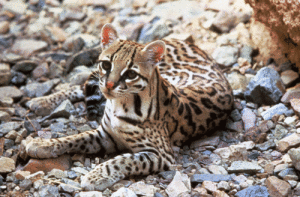
Photo By Tom Smylie – US Fish & Wildlife Service
As a new-comer to Texas, I am always learning new and fascinating things about the wildlife in this state. One of the most beautiful animals I’ve learned about recently is the Ocelot. Ocelots are wild cats that live in South Texas all the way down to Northern Argentina. In Texas, their habitat is mainly dense chaparral brush and they den in caves, hollow trees, and thickets, so they’re difficult to find.
The most striking thing about Ocelots is their complex coat that looks like a mixture between a cheetah and a tiger. They also have a long tail and big eyes. Ocelots are about the size of a bobcat, growing as long as three and half feet long and weighing up to 35 pounds. They feed on prey such as small mammals, reptiles, and birds and can even take down young deer. These cats are mostly nocturnal, and so tend to do their hunting at night.
Observations of Ocelots at zoos and sanctuaries tell us that these cats have various methods of communicating with one another. They use body language, scent markings, and vocalizations to mark their territories, call to each other, or express displeasure. The San Diego zoo describes an Ocelot “threat posture” that involves an arched back, stiff legs, and straight tail. As a housecat owner, I can attest that this is a very threatening posture.
Another method of communication is physical markings. A male Ocelot marks his territory by clawing logs, urinating, and leaving feces around. This tells other males to keep far away. Male ocelots maintain a territory that overlaps the territories of four or five females, so they can easily find a mate. And when they do find a mate, they don’t stay together to raise the young.
The Ocelot mother is pregnant for just over two months before she gives birth to 1-4 kittens. Baby ocelots are marked with their signature spots at birth, but their coat is gray and their lower limbs are dark. Additionally, the eyes of a baby Ocelot are blue and change to brown after about three months. The mother ocelot teaches her babies to hunt when they are young, and by the time they turn eight months old, the kittens’ adult teeth are in, and they can hunt for themselves.
While Ocelots have a wide range, the ones that live in the U.S. are doing poorly, and the Texas Ocelot subspecies Leopardus pardalis albescens is federally endangered. Ocelots used to live throughout Texas, east Arkansas and Louisiana, but are now only found in the very Southern part of Texas. Current estimates say that there may be as few as 100 wild Ocelots still living in the U.S. This is due to hunting, poisoning, trapping, and habitat loss.
Fortunately, there are great organizations making strides to help save these cats. The Nature Conservancy and the U.S. Fish and Wildlife Service, for example, are protecting and restoring the wildlife corridors that Ocelots use to roam between Mexico and Texas. Additionally, hunting, poisoning, and trapping of Ocelots has been greatly reduced. Because of this, conservationists are hopeful that the species will be able to bounce back. I hope so too!
